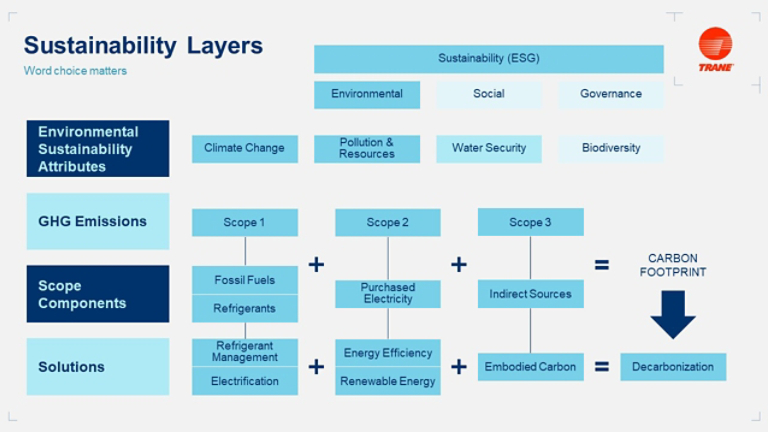Quick Facts
- Topics
- Sustainability • Decarbonization • Efficiency • Energy Services

About the author
Trevor Joelson, Decarbonization Program Lead – Key Accounts
Trevor Joelson is a program lead for Trane’s decarbonization program for key account customers. Through this program, Trevor collaborates with larger enterprises to define their environmental sustainability objectives and establish initiatives and programs to reduce operational emissions through financially attractive and measurable projects.
Trevor joined Trane through an acquisition of Fellon-McCord in 2016 and has held various roles in corporate energy & sustainability management over the last decade. His subject matter expertise is in the energy markets and how the supply-side of energy connects to the built environment.
Trevor lives with his family in Dallas, TX and is a graduate of the University of Louisville.

As is illustrated in the graphic above, three components make up your sustainability program: Environmental, Social, and Governance – commonly referred to as ESG. Your carbon footprint is comprised of three “Scopes” – Onsite, Energy, and Value Chain.
- Scope 1 “Onsite” emissions are emissions used directly within your operations and are commonly made up of fossil fuels.
- Scope 2 “Energy” emissions are electricity purchased from the electrical grid. While you are accountable for these emissions, it is not directly in your control.
- Scope 3 “Value Chain” emissions are a more complex set of emissions related to the creation and transportation of products and services.
Making changes to reduce emissions in any of these three scopes is how you achieve decarbonization. Working with an expert, you can determine the appropriate mix of initiatives within this framework to achieve your sustainability goals while supporting your business and financial goals.
Step 3: Make a Decarbonization Plan
Decarbonization comes down to four main components: Energy Efficiency, Electrification, Renewable Energy, and Refrigerant Management. Let’s look at what goes into each component.
- Energy Efficiency
The goal of energy efficiency is to help improve the building’s infrastructure to eliminate waste in your operations. This can be done by upgrading to more efficient equipment, making improvements to limit the heat entering or escaping from the building, or reducing the load it takes to heat or cool the space.
The process of becoming more energy efficient starts with simple, cost-effective measures such as identifying and addressing air leaks to installing sophisticated building automation systems that monitor energy use and waste in real-time. A great way to gain greater efficiency is to start with an energy assessment.
Upgrading to high-efficiency equipment, including HVAC and lighting, helps to reduce the overall cost of ownership and may help to improve the energy efficiency within your building. Installing automation systems allows you to centrally monitor and manage the energy in buildings across the country, leading to significant savings. Your building and energy expert can work with you to find ways to pay for building upgrades now by using future energy savings.
- Electrification
To create a greener energy grid, renewable energy sources like solar and wind are being developed. This means electricity is becoming less emission-intensive across North America. One of the best ways to take advantage of these greener energy sources is to electrify your heating and cooling operations. An emerging decarbonization strategy is to transition space and process heating equipment to system designs and equipment standards that allow for all electric, net-zero ready operations. Building and business owners in areas with clean, low-cost electric grids will see more near-term benefit for electrification of heat. That said, electric heat is 'net-zero ready', because it can ultimately be supplied by a renewable energy source. This is a huge advantage for any building looking to achieve decarbonization goals.
Since utilities are making significant investments to update the grid, many are incentivizing customers to take advantage. The right expert can help you determine how you can receive reimbursements from utilities that can support electrification updates.
- Renewable Energy
Building and business owners can leverage renewable energy as a tool to help reduce emissions while gaining more control over their energy supply. While renewable energy has historically been seen as a “cost premium” to traditional energy sources, there are emerging models that allow buildings to secure renewable energy at a discount to traditional power sources.
Building owners should explore all the renewable energy options available to them and identify which one has the best alignment and significant returns to the business
There are two main ways to secure renewable energy:
- Onsite: A renewable energy asset or system is installed at the facility and provides energy supply directly to the building.
- Offsite: A commitment is made to an offsite renewable energy asset (likely a large utility-scale development) that allows the owner to recognize the renewable energy attributes.
- Onsite: A renewable energy asset or system is installed at the facility and provides energy supply directly to the building.
- Refrigerant Management
The often-overlooked costs of refrigerant leaks could be impacting both the environment and your bottom line. A solid refrigerant management strategy starts with baselining, tracking, and managing the losses of refrigerants, and looking for ways to reduce refrigerant losses. While this is important from a reporting perspective, getting a handle on refrigerant leaks will also improve equipment performance and reduce service events.
The second step is to assess the global warming potential (GWP) of the refrigerants currently used in systems and look at transitioning to lower GWP refrigerants as equipment is upgraded or in future investments.
Building owners and business executives like you will have growing pressure to decarbonize their operations in the years to come. There are unique challenges, as well as immense benefits, that come with reducing emissions while avoiding negative impacts to core business operations and customer experiences. Balancing these challenges by developing a roadmap to decarbonization that focuses on creating financially attractive solutions to achieve your goals is a core competency of the expert teams that support Trane Energy Services.
Looking to begin, accelerate, or complete your decarbonization journey? Connect with a Trane expert to develop a financially attractive solution to meet your sustainability ambition.
